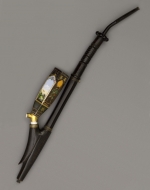Simplicity and luxury
March 2018

Porcelain pipes with paintings of church windows originate from the town Pirkenhammer in Bohemia, Germany, nowadays Czech Republic. They were conceived around 1830 and exploded into a craze that lasted for about 15 years. Such a pipe is depicted here with a six-sided flattened bowl of the usual, so-called stummel shape. Church windows are painted on the flat sides, transparent windows through which you can see a brightly coloured rural environment. These Gothic windows were often alternated with statues of knights executed in a dark palette, suggesting church sculptures. Alternating, both paintings give a nice rhythm of light and dark. What often happened with luxury goods is that their target group gradually declined. That is not surprising because the production in Pirkenhammer was so large that new customers had to be found all the time. For the smoker with the smaller purse, these luxury pipe bowls were mountedin a less luxurious manner, which considerably increased the clientele. This pipe is such a cheaper version. Although the pipe bowl is still completely hand-painted, the mounting is simpler to almost substandard. The moist trap below the bowl of the pipe looks like a blackened buffalo horn, but it is made of wood and finished with simple black paint. The rising stem has the usual quality, but the pipe bowl is never fitted with a hinged lid, another sign of simplicity. Despite of this appearance, this pipe will have had sufficient regard in the Biedermeier household, more a Sunday pipe than a daily smoker.
Amsterdam Pipe Museum APM 22.427
Archive object of month